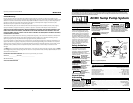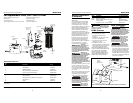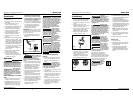
Model ISP40
Troubleshooting Chart
Problem Possible Cause(s) Corrective Action
1.Power outage
2.Blown AC breaker
3.GFCI tripped
4.Low AC voltage
1. Pump fuse may be blown
2. Pump impeller may be
damaged
Low battery
1. Battery polarity is incorrect
2. Battery voltage too low
1. Lower float stuck
2. Pump too low in sump
1. Pump power cord
2. Upper float switch stuck
3. Impeller rotor jam
1. Backflow from discharge
pipe
2. Pump too low in sump
3. Clogged pump filter
1. Blocked discharge pipe
2. Partially clogged pump
filter
3. Broken thrust bearing
1. Discharged battery
2. Shorted cell battery
1. None
2.Push AC breaker to reset. If breaker trips again, do not reset.
Have unit checked by qualified electrician
3. Reset GFCI
4. Have outlet checked by electrician
1. Replace pump fuse. Use Bussmann AGC10 or Littlefuse 312010
2. Remove impeller. Check for damage to bore or bearing
Apply AC power or replace batteries
1. Recheck battery polarity
2. Replace batteries
1. Remove filter and clean. Remove debris from float switch area
2. Place a brick under the pump
1. Check for proper installation of power cord into the PS/BC
2. Remove filter and clean. Remove debris from float switch area
3. Remove filter and clean. Remove debris from float switch area
1. Install or replace check valve
2. Place a brick under the pump
3. Remove filter and clean
1. Check for restrictions in discharge line, flood is immanent. Shut
off AC power before entering flooded area
2. Remove impeller, check for debris in inlet
3. Remove and inspect thrust bearing
1. If the battery is in otherwise good condition, it is normal for
the circuit breaker to cycle ON and OFF several times before
the battery recovers enough to allow a normal charge rate. If
this happens on a regular basis, however, the batteries may be
too large for the PS/BC and it could be damaged. Replace
batteries
2. A battery in this condition may cause the breaker to cycle
continuously. The battery will not accept a charge. Replace
both batteries
AC Power Indicator
(red light) is not on
Alarm sounds - yellow
light is on
Alarm sounds - yellow
light is on and red
light is off
Green Light is off
Pump will not stop
Pump will not start
Pump starts/stops too
often
Pump operates but
delivers little or no
water
“Click” inside PS/BC.
An overload is
indicated when you
hear a distinct “click”
from the DC circuit
breaker internal to the
PS/BC. A 3-5 minute
cooling off period
occurs before the PS/BC
resets itself. If the
overload condition still
exists, the cycle will
repeat. Regardless of
what is causing the
circuit breaker to cycle,
unattended or routine
operation in this
manner could result in
serious damage to the
PS/BC and the battery.
www.waynepumps.com
Pump Installation
Installation may
take several hours.
Do not disable an existing sump pump
until you have established an
appropriate way to evacuate sump pit.
1. Install pump in a sump pit with
minimum size as shown in Figure 2.
Construct sump pit of tile, concrete,
steel or plastic. If the sump pit
already exists, disconnect power to
existing pump and make certain pit
is the correct size.
2. The sump pump should be located
on a solid, level foundation. Do not
place pump directly on clay, earth,
gravel or a sandy surface. These
surfaces contain small stones, gravel,
sand, etc. that may clog or damage
the pump and cause pump failure.
Remove any silt or debris from the
sump pit and surrounding area.
Flood risk. If
flexible discharge
hose is temporarily used, make sure
pump is secured in sump pit to prevent
movement. Failure to secure pump
could result in flooding and property
damage.
Flexible discharge
hose is intended
for temporary use only. Rigid PVC or
metal pipe is required for a permanent
installation.
3. Thread check valve (not included)
into pump body. Avoid stripping or
cross threading. Do not use pipe
joint sealant.
4. The pump has a 1-1/2” NPT discharge.
If the existing piping is smaller, use an
adapter. Smaller diameter piping will
reduce the pump flow rate and
decrease its performance. Do not
reduce below 1 1/4”.
NOTICE
!
WARNING
NOTICE
7
5. Connect rigid pipe to rubber boot on
check valve. Tighten hose clamps.
Support pump and
piping when
assembling and after installation.
Failure to do so could cause piping or
check valve to break, pump to fail, etc.,
which could result in property damage
and/or personal injury.
6. Protect electrical cord from sharp
objects, hot surfaces, oil and
chemicals. Avoid kinking the cord.
Replace a damaged cord immediately.
7. A sump pit cover must be installed to
prevent debris from clogging or
damaging the pump.
8. Fill sump with at least 6 inches of
water.
Multiple pump
systems
When installing more than one pump
in a sump it will be necessary to decide
if the AC/ DC Sump Pump will be
installed as a primary or as a back up
sump pump. The manufacturer
recommends the AC/ DC Sump Pump
be installed as a primary pump. A
conventional AC powered electrical
back up pump can be installed
alongside as shown in Figure 3. You
will need to raise the electrical back up
pump by placing it on a brick, or by
adjusting the float so that the
electrical pump turns on above the
level of the AC/ DC Sump Pump.
!
WARNING
2
Operating Instructions And Parts Manual
Operating Instructions and Parts Manual
If the AC/ DC Sump Pump is to be used
as a backup for an electrical primary
pump it is important to maintain a
minimum water level of 6 inches in the
sump when measured from the bottom
of the AC/ DC Sump Pump. The water
is needed to allow the AC/ DC Sump
Pump to go through its 24-hour testing
cycle. You will need to adjust the off
level of the Electrical Primary Pump to
turn off at the minimum water level of
6 inches as shown in Figure 4.
The on level of the Electrical Primary
Pump must turn on before the 11 inch
on point of the AC/ DC Sump Pump.
Do not raise the AC/ DC Sump Pump
above the level of the Electrical
Primary Pump.
If it is necessary to have the primary and
back up pumps discharge into a common
line, check valves will be required on
both pumps to eliminate back
reticulating flow into the inactive pump.
Battery Information
The system is designed to operate
most efficiently with sealed lead acid
(SLA) batteries at 24 volts. Two 12-volt
40-amp hour SLA batteries provide
enough energy to pump more than
10,000 gallons of water from a
basement. Deep cycle marine batteries
can also be used.
Sealed lead acid batteries cost slightly
more, but they can last longer. Wayne
offers a 40 amp hour battery, 66900-
Model ISP40
Figure 2
15”
Min.
10” Dia.
Min.
www.waynepumps.com
Amp Hours Per Battery Total Gallons Pumped*
40.0 11,000
80.0 22,000
120.0 33,000
* Assumes the sump pump is lifting water 10’
CHART 1 - STANDBY POWER PUMPING CAPACITY
18” Min.
22”
Brick
Figure 3
22”
18” Min.
Minimum
Water Level
Primary
Off Point
6”
Figure 4






